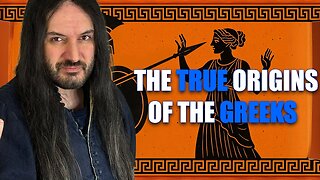Premium Only Content

Bet On It! Shooting From The Hip - 55 - Third Eye, Pineal Gland, Siddhis Powers
According Wikipedia: Third Eye: -also called the mind's eye or inner eye -usually depicted as located on the forehead, supposed to provide perception beyond ordinary sight
Hinduism & Buddhism: the 3rd eye refers to the ajna (or brow) chakra -both Hinduism & Buddhism, the 3rd eye is said to be located around the middle of the forehead
- representing the enlightenment one achieves through meditation
- in Eastern spiritual practices, 3rd eye refers to a gate that leads to the inner realms & spaces of higher consciousness -often symbolizes a state of enlightenment
- is often associated with religious visions, clairvoyance, the ability to observe chakras & auras, precognition & out-of-body experiences
Taoism: 3rd eye training involves focusing attention on the point between the eyebrows with eyes closed, while the body is in various qigong postures
- goal of this training is to tune into the correct "vibration" of the universe & gain a solid foundation on which to reach a more advanced meditative state -Taoism asserts that the 3rd eye is one of the main energy centers of the body located
Theosophy:
- theosophist H. P. Blavatsky suggested the 3rd eye is the partially dormant pineal gland, which resides between the 2 hemispheres of the brain
Rick Strassman: hypothesized the pineal gland, which maintains light sensitivity, is responsible for production & release of DMT (dimethyltryptamine), an entheogen which he believes could be excreted in large quantities at the moments of birth & death
Pineal Gland:
-pineal gland (also known as pineal body or epiphysis cerebri) is a small endocrine gland in the brain of most vertebrates
-it produces melatonin, a serotonin-derived hormone, which modulates sleep patterns
-shape of the gland resembles a pine cone, which gives it its name
-is located in the epithalamus, near the center of the brain, between the 2 hemispheres, tucked in a groove where the 2 halves of the thalamus join
-Ancient Greeks 1st to notice the pineal gland & believed it to of valve, a guardian for the flow of pneuma(Pneuma: ancient Greek word for "breath", in religious context "spirit")
-17th century philosopher Rene Descartes regarded the gland as having a mystical purpose, describing it as the "principal seat of the soul"
-mid-20th century, the biological role as a neuroendocrine organ was established
Siddhi:
-In Indian religions, Siddhis (Sanskrit: siddhi; fulfillment, accomplishment)
-are material, paranormal, supernatural, or otherwise magical powers, abilities & attainments that are the product meditation & yoga -the term ṛddhi ("psychic powers") is often used interchangeably in Buddhism
-The Visuddhimagga is one of the texts to give explicit details about how spiritual masters were thought to actually manifest supernormal abilities -It states that abilities such as flying through the air, walking through solid obstructions, diving into the ground, walking on water & so forth are achieved through changing one element, such as earth, into another element, such as air
Eight classical siddhis: below are the 8 classical siddhis (Ashta Siddhi) or 8 great perfections
-Aṇima: the ability to reduce one's body to the size of an atom
-Mahima: the ability to expand one's body to an infinitely large size
-Laghima: the ability to become weightless or lighter than air
-Garima: the ability to become heavy or dense
-Prapti: the ability to realize whatever one desires
-Prakamya: the ability to access any place in the world
-Īsitva: the ability to control all material elements or natural forces
-Vasitva: the ability to force influence upon anyone
In Tantric Buddhism, siddhi specifically refers to the acquisition of supernatural powers by psychic or magical means or the supposed faculty so acquired -including: clairvoyance, levitation, bilocation & astral projection, materialization & having access to memories from past lives
-
 17:37
17:37
MetatronHistory
23 hours agoThe REAL Origins of the GREEKS
22.3K12 -
 1:19:32
1:19:32
The Daily Signal
8 hours ago $8.56 earned🚨BREAKING: James Comey & Letitia James NOT "Off the Hook" on Indictments, Sen. Kelly Court Martial?
25.8K3 -
 4:46:23
4:46:23
Drew Hernandez
23 hours agoBONDI DOJ BLOWS IT ON COMEY/LETICIA INDICTMENTS?!
36.3K18 -
 2:34:03
2:34:03
PandaSub2000
4 days agoLIVE 10:30pm ET | CARMEN SANDIEGO
27.1K1 -
 12:10
12:10
Robbi On The Record
1 day ago $5.10 earnedKarmic Disclosure and Predictive Programming
32K4 -
 4:57
4:57
Gamazda
6 hours ago $5.83 earnedAerosmith - Dream On (Piano by Gamazda)
21.1K13 -
 8:12
8:12
Freedom Frontline
9 hours agoChip Roy DESTROYS Democrat After She Explodes Over Shutdown Truth
14.1K4 -
 2:29:50
2:29:50
We Like Shooting
17 hours ago $3.05 earnedWe Like Shooting 638 (Gun Podcast)
12.6K -
 46:09
46:09
MattMorseTV
6 hours ago $24.68 earned🔴Bondi just DROPPED the BALL... BIG TIME.🔴
25.7K134 -
 23:57
23:57
Jasmin Laine
10 hours agoCarney SNAPS at Reporters—MOCKS Trump and it BACKFIRES IMMEDIATELY
17K44